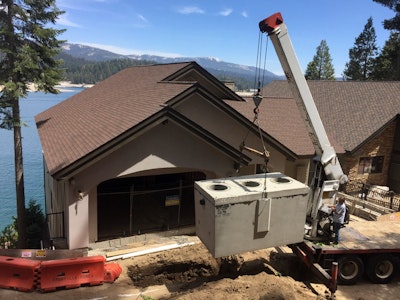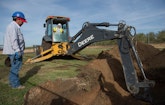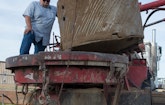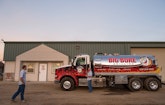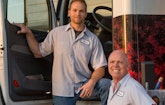
Interested in Plumbing?
Get Plumbing articles, news and videos right in your inbox! Sign up now.
Plumbing + Get AlertsHenry Damm remembers the day in the early 1970s when he saw a truck-mounted drilling rig at a neighbor’s house with the name Big Bore Drilling & Certified Cesspool emblazoned on the side. “The workers were installing a seepage pit for a septic system,” he recalls. “I was about 12 years old at the time and I wanted to jump in that truck and play with it.”
Ironically enough, Damm’s wish came true — it just took 17 years or so to happen. Since 1989, Damm and his wife, Beverly, have owned the 57-year-old septic pumping, onsite installation and repair company, now known as Big Bore Drilling Certified Septic and Hydroflushing. And they’ve spent nearly three decades making their own memorable impression on customers in and around Fresno, California.
“Whatever we promise to do for a customer, we try to do even more,” says Damm, explaining why word-of-mouth referrals have been his best marketing tool. “Providing great customer service is really key. We get just one opportunity to install a septic system, so we want to go above and beyond … so they tell their neighbors to use Big Bore Drilling, too.
“A lot of times, our customers mention that their grandfather hired Big Bore,” he adds. “If we’d have messed up (years ago), that family wouldn’t be calling us again.”
Established in 1959, the company has experienced a lot of changes since it was first profiled in Pumper magazine 22 years ago. “For starters, I still had hair back then,” quips Damm.
In terms of gross revenue, the company is roughly 2 1/2 times bigger. It employs 11 people and has built up a sizable fleet of equipment. Cellphones and GPS units have replaced radio dispatching, email has rendered faxing obsolete, and the internet is displacing phone book advertising. In addition, newer and more stringent California laws governing engine emissions and septic system installations have added to the cost of doing business. But one thing has remained the company’s calling card: An unswerving commitment to customer service.
NEW CAREER PATH
Damm never expected to be a player in the septic pumping industry. In fact, from ages 18 to 28, the industrious entrepreneur — now 55 years old — started and ran his own window-washing company in Fresno.
“I’m pretty good with my hands,” he adds. “I’m very capable of doing things and figuring out how to do them better. We competed on speed in the window-cleaning business, so I was always all about continual improvement, and being faster and better than the next guy. I also liked being my own boss and having the flexibility to work the hours I wanted while attending college.”
That drive and determination, coupled with a strong work ethic and an independent streak, served him well after he decided to trade squeegees for vacuum hoses.
“When I was first approached about the opportunity, I thought to myself, ‘Be a septic contractor — are you kidding me?’” he laughs. “No one dreams about being in the septic industry when they grow up. But the business had a great customer base … it looked like a really good opportunity. Plus, I remembered seeing Big Bore Drilling when I was a kid. That really intrigued me.”
Damm’s father-in-law, Don Davis, helped him finance the purchase of the business. (Damm bought out Davis’ share of the business about 10 years ago.) He also credits much of his success to Bob Boone, who was the general manager of Big Bore when Damm bought the company. Damm asked Boone to stay on board to help with the ownership transition and he ended up staying for 10 more years.
RUGGED EQUIPMENT
The company is named for one of its most important pieces of equipment: A big-bore bucket drill rig, made by Calweld and mounted on a 1999 International truck chassis. Capable of drilling a hole up to 10 feet in diameter, the drill is used to dig seepage pits, which are sometimes used instead of leach chambers because of the area’s rocky terrain.
“In certain areas, there’s 10 to 15 feet of hardpan around here, so there’s no way to get drainage,” Damm explains. “So we drill seepage pits that are usually 30 to 50 feet deep and 4 feet in diameter, then line them with bricks.” The whole process takes about four hours on average, and the cost is comparable to installing a conventional leach line, he adds.
The company also owns a vacuum truck built out by Imperial Industries on a 2016 Peterbilt chassis with a 3,600-gallon aluminum tank and a National Vacuum Equipment blower; a Vactor 2100 vacuum/hydroexcavating truck, built on a 2012 Kenworth truck with a 12-cubic-yard debris tank, a 1,500-gallon water tank and a Howden Roots blower; and a 1964 Peterbilt flatbed truck that carries a 10-ton-capacity crane made by Quick Lift.
In addition, Big Bore relies on a 1999 International with a Reliance Trailer dump body for hauling rock (25-ton capacity); a transfer trailer made by Reliance; two John Deere 710K backhoes; a Myers truck-mounted water jetter (65 gpm at 2,500 psi) equipped with a 1,500-gallon water tank and hoses made by Piranha Hose Products; and a 5-ton International flatbed truck, used for hauling bricks. Miscellaneous equipment includes a GenEye pipe detector made by General Pipe Cleaners (a division of General Wire Spring Co.) and a Crust Busters tank agitator made by Schmitz Bros. For installations, Damm says he uses concrete septic tanks made by Jensen Precast.
DIVERSIFICATION EFFORT
The Vactor vacuum truck/hydroexcavator and the trailer-mounted Myers water jetter are emblematic of the most dramatic change at Big Bore during the last 10 to 15 years: service diversification. Initially, Damm says he was content to take an if-it-ain’t-broke, don’t-fix-it approach with the already successful business. “But eventually, we started adding more services,” he explains. “We started doing anything we could do to serve our customers better.”
Today, septic pumping, installations and repairs still account for the lion’s share of the company’s revenue — roughly 90 percent. The rest comes from waterjetting pipelines and hydroexcavating, he says.
Damm’s entry into jetting pipelines came about entirely by happenstance. He was working for a local plumbing contractor pumping out septic tanks and performing septic system repairs, when the plumber was bought out by a national chain that didn’t want to do waterjetting. “So he asked me to buy some of his equipment,” Damm says. “I bought the Myers jetter, and the next day we cleaned a line at a local college.
“We basically learned how to use it through on-the-job experience, but the machine paid for itself after two weeks,” he continues. “Then we realized that a lot of people were moving dirt from point A to point B on farm pipelines and dairy lines. So around 2001, we bought a Vac-Con vacuum truck to suck up the dirt as we jetted. And when that truck wore out, we replaced it with the Vactor.”
Expanding into pipeline cleaning jobs made sense because it complemented Big Bore’s existing services. It also allowed the company to leverage its existing customer base, because many existing farm and dairy customers already used the company to clean and repair their septic tanks, Damm explains.
A BRIGHT FUTURE
Looking ahead, Damm says he’s comfortable where the company is right now, but he’s also not opposed to further growth. In that vein, he envisions hydroexcavating and pipeline waterjetting becoming bigger contributors to the company’s bottom line. Those services will help offset the loss of customers created as the city converts more homes from septic to sewer service, he adds, noting that his own house is now served by sewer service instead of a septic system.
“I also hope to buy a camera van and start a second leg in that (pipeline jetting) industry,” he says. “I’d like to provide both pipeline cleaning and video services for municipalities that don’t have that equipment. The septic business keeps moving away from us. … We have to go out farther and farther because sewer lines keep taking customers away as the city grows. That used to concern me, but it’s never really affected our work, aside from the fact that we have to travel further.”
Damm is also preparing for his son, Jason, to eventually run the company. There’s no formal time frame for that, but he hopes such a succession occurs when Damm and his wife decide to retire.
In the meantime, Damm says he has no regrets about jumping into a field he never expected to enter. “I still really enjoy meeting with customers — talking to them and seeing how we can meet their needs,” he says. “I love to explain what we’re going to do and leave their yards looking better than we said they would. It’s so much better to have happy customers than having people wish you hadn’t come.”
How to minimize employee turnover
Most employees at Big Bore Drilling Certified Septic and Hydroflushing have been with the company for more than 10 years, and several for more than 20 years. But Henry Damm, who owns the company with his wife, Beverly, believes the days of long-tenured employees are slowly fading away.
Like so many contractors nationwide, Damm is far more worried about just finding qualified people to hire in the short term, much less keeping them on board for decades. In fact, he’s found it far more viable to hire family members, such as his nephews, Jeremy Davis and Brice Liden, and his son, Jason, than casting a wider hiring net.
“The few times I’ve used outside services to find new employees, they’ve turned out to be the worst people I’ve ever hired,” says Damm.
Referrals from current employees used to be a great way to recruit new employees. But now that most of his employees are edging closer and closer to retirement, their friends and acquaintances are older, too, so they can no longer connect Damm with the younger people he needs to keep the company going for another generation. That’s a painful realization, he says.
“Many of my employees are getting closer to retirement … and I’m having a very difficult time finding that next generation of workers,” he says. “We need to start training that next generation so that when Jason takes over, he has a staff in place that’s able to do what we do. That’s part of my exit plan.” He says he’s even started to ask pastors at churches if they know of good potential employees.
Hiring good people is critical because training them, then losing them shortly thereafter, is an expensive proposition. “We need to invest a lot of money in training, plus they need to get a commercial driver’s license,” he explains. “That all costs money, so I need to know they’re going to stick around.”
To retain employees, Damm says he pays competitive wages and also gives cash bonuses if the company is doing well. He says that as the backbone of the business, employees need to be rewarded when the company does well financially. In addition, the company offers employees a 401(k) program, free work uniforms and vacation time. “And if they don’t use all of it, I pay them for the unused time,” he adds.
The company also invests in good, reliable equipment. That can help recruiting efforts because no one likes to work with machines that constantly break down, he notes.
Furthermore, Big Bore considers employees part of the family. “We try to treat them the way I’d like to be treated,” he notes. Moreover, Damm practices a hands-off management style that he believes also contributes to low employee turnover. He welcomes new ideas about how to improve operations and processes and encourages employees to try new techniques and strategies. “If it doesn’t work, we’ll learn from it and move on,” he says. “But I don’t dictate how things should be done.”
